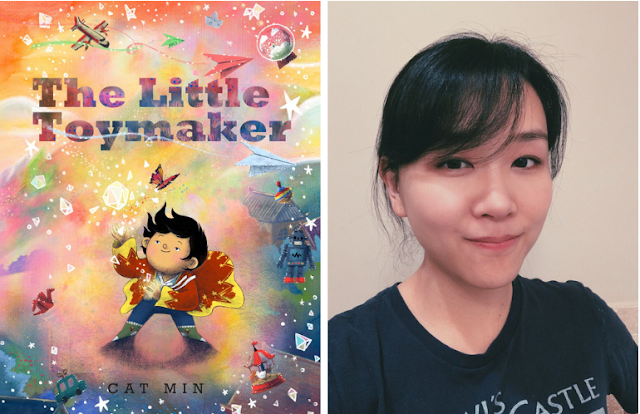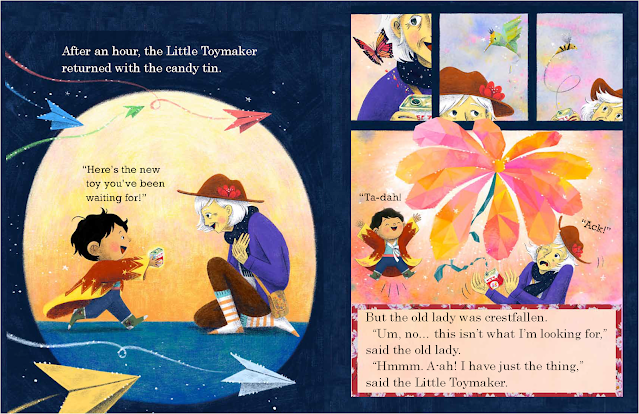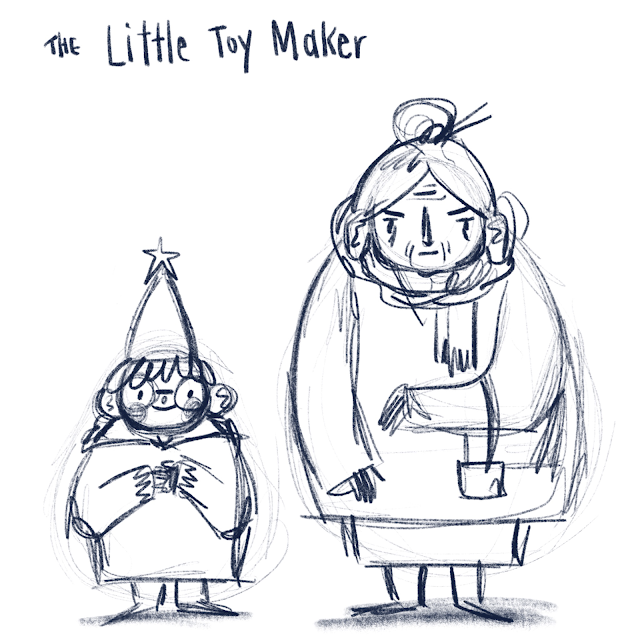I am so grateful I had a chance to talk to author-illustrator Cat Min about The Little Toymaker! This is Cat's second book—her debut was Shy Willow—so it was such a pleasure catching her at what I know is going to be a long and illustrious career as a picture book creator! Enjoy!
About the book:
We all know about the guy in the red suit at the North Pole. But what if the world's toymaker was a little boy?
The adorable little Toymaker makes wonderful toys... not for children, but for their grandparents and other older folk. (People often forget that they, too, like toys!) But it isn't always easy.
One morning, an old woman brings the little Toymaker a candy tin she played with as a girl.
The little Toymaker takes the tin and TA-DA! comes back with a sparkling new toy for the old lady. But it seems that what she truly wants was lost a long time ago. And it will take all the Toymaker's skill, magic, and empathy to bring it back for her.
Peek underneath the dust jacket:
Let's talk Cat Min!
LTPB: Where did the idea for The Little Toymaker come from?
CM: It all started with a quick pencil drawing I did back in 2019 of a wind-up toy turtle that had a snow globe for its shell. I imagined that a little wizard had made it while I was drawing it. Then one idea led to another idea. This little wizard is actually a little toymaker, and he makes toys–not for kids–but for older people. But why for older people? Because people often forget that they, too, like toys. It couldn’t be just any new toy–it would have to be a toy from their childhood that the little toymaker would remake into something magical.
When I look back at it now, after having finished the story and art, I think this idea came to my mind because I was in a very nostalgic state at the time. I was new to motherhood and having this new identity as a mother had a huge impact on me. Becoming a mother meant new beginnings, new experiences, new happiness, but at the same time for me it also meant losing some part of my past self. In my free time, I would rummage through drawers and storage boxes to actively seek out old things from the past like photos, drawings, keychains, postcards, and letters to remember what I was like when I was 12 years old, what kind of friendships I had when I was 8 years old, what sort of things I was interested in when I was 21 years old. Did I still identify with all of my different past selves? If I did, what am I doing that keeps that past part of me still a part of me now? And if I didn’t, what had happened? What had changed? Do I miss that part of me, or am I glad that part of me no longer exists in the present me? I guess that’s why it was natural for me to make the story about the little toymaker meeting an old lady instead of an old gentleman. She feels a certain void in her heart, so she brings a favorite toy from her childhood to the little toymaker in hopes to heal that part of her. And it’s only after the old lady shares her story with the little toymaker that he is able to finally give her what she’s been looking for.
LTPB: Can you talk a little bit about the visual evolution of The Little Toymaker? As you got to know the characters, how did your illustrations evolve?
CM: In the very early stages of developing the story and art, I imagined that everything in The Little Toymaker was just pure fantasy. The little toymaker lives in an old wooden tower on top of a rainbow mountain, so he would also have to be this character that was not of this world. He would have a hat that covered all his hair, and wrapped up in layers of clothing that were also in a rainbow pattern. The old lady also had a hat that covered most of her hair and her hair was grayish white. Both the little toymaker and the old lady did not have a very clear identity, other than that one was a child and the other was an elder.
The Little Toymaker went through multiple revisions, but the best feedback I got from the editor Arthur Levine and the art director Joy Chu was to put more of myself in the story and art. In the final character design, the little toymaker doesn’t have his hat anymore and we get to see his black hair freely flowing and dancing when he uses his magic. It is also clear that he is an Asian boy, which made it very easy for me to add little details throughout the book that gives further hints on his background (jasmine tea and mooncakes during tea time, origami hanging from the roof and ceiling, etc).
The old lady went through drastic changes, too. Joy had sent me dozens of images of different old ladies, showing me all the different ways old ladies could look like. She had also sent me images of Joan Didion (before she passed away) who was very thin, and it was quite shocking for me because the old ladies in my imagination were all like Mrs. Claus. Joy had also asked me, “what would you want to look like when you’re an old lady?” and this question really got me thinking about what the old lady would look like in The Little Toymaker. The old lady’s final character design is a combination of these reference images and what I imagine I’d look like when I’m an old lady. These character design changes affected the whole look and feeling of the illustrations. At first, the rainbow mountain was a stack of geometric shapes and patterns and the characters were more abstract than real. In the final illustrations, the characters have more realistic features that make it easier to identify who they are and the settings and details are clearer rather than being more abstract, which I think makes the magic feel like it’s real.
LTPB: How do you feel your animation background contributes to your illustration style? For you, what are the major differences between animation and illustration? What was the hardest part of transitioning from screen to book?
CM: I think my background in animation and film makes me see a story flow more in sequences. There are several moments in Shy Willow where there are no words and only illustrations, and sometimes they are broken up into sequences like in a graphic novel. This can also be found in The Little Toymaker. Sometimes an illustration can stand alone without words to tell a certain part of the story, and sometimes breaking a moment up into a wordless sequence can show the gradual change of a character's emotion or help build up the climax of the story. You see this more often in animation and film where a significant moment is emphasized with nothing but a long pause on the protagonist’s close-up face or watching the protagonist walk slowly from one point to another. With a moving image, you can pace what the viewer sees on screen, but with picture books, the pace is left entirely up to the reader, so you try to pace the story as much as you can with these stand alone illustrations and wordless sequences. It is my attempt at trying to bring out that emotion that I want to evoke when reaching a certain part of the story, which I think is easier to do on the screen with music, pacing, and sound effects.
LTPB: What did you use to create the illustrations in this book? How did your process change from how you worked on your debut Shy Willow, which was published last year?
CM: I used watercolor and colored pencils on watercolor paper. I then scanned the artwork to the computer/iPad and used Photoshop and Procreate to change or add more details to the art. The process was pretty much the same when working on the art for Shy Willow. The only difference is that for The Little Toymaker I relied heavily on Procreate to make final revisions and to add little details like the tiny sparkles that you see all around the toymaker’s workshop.
LTPB: What are you working on now? Anything you can show us?
CM: Yes! I’m working on my third picture book The Shadow and the Ghost slated for Spring 2024, also published by Levine Querido. It's about the unlikely friendship between a shadow and a ghost. I can’t say much now because it’s in the early stages of development, but I can't wait to share more details soon!
LTPB: If you got a chance to write your own picture book autobiography, who (dead or alive!) would you want to illustrate it, and why?
CM: Oh, I love this question! It would never happen but it would be an absolute dream to have Shaun Tan illustrate my own picture book autobiography because his picture books are pretty much the reason why I wanted to become a picture book author-illustrator. I feel like he would take my story and turn it into something interesting, something magical with his beautifully surreal illustrations (hmm, sounds a little familiar haha). He’s so good at taking the words on the page and creating the illustration for that part of the story to tell something deeper, to get the reader thinking and questioning and searching even after finishing the book.
A big thanks to Cat for taking time to answer questions for me! The Little Toymaker published earlier this month from Levine Querido!
Special thanks to Cat and Levine Querido for use of these images!

This post contains affiliate links. For more information, visit my policies & disclosures page


























This looks delightful!
ReplyDelete